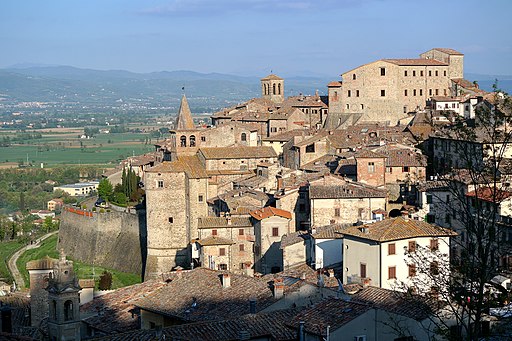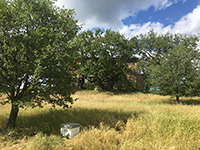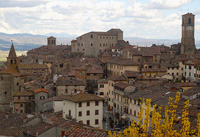Anghiari |
Anghiari is a town and comune in the Province of Arezzo. |
Anghiari, Veduta del Castello di Montauto
|
| Montauto was already in existence during the Etruscan period (VIII to V centuries BC ), and the settlement took advantage of the territory’s rich copper mines. It was a Roman/Byzantine lookout tower and came under the dominion of a feudal lord, Goffredo. The distinctive feature of the Castle di Montauto is the cylindrical tower on its corner. The castle itself has its origins in 1170-80.
Together with villa La Barbolana and Castello di Galbino, the Castle di Montauto was one of the residences of the old Galbino family. Here Francis of Assisi, not yet a saint, is said to have rested for a few days, after he had received the stigmata at La Verna in 1224. While here, Count Alberto gave Francis a new priest's habit in exchange for the old, stained one. This was soon considered a precious relic and was kept in the castle’s chapel until 1502 when the Florentines brought it to Florence. The habit of Montauto is now displayed in the Santuario della Verna.[2]
|
|
|
From Anghiari to Sansepolcro, on the sites of the Battle
|
||
Map | From Anghiari to Sansepolcro, on the sites of the Battle
|
||
There is a walk along the route that leads from Anghiari to Sansepolcro and viceversa, that retraces the steps of the troops who fought in the battle: starting from the Museum, passing the Maestà shrine of S. Maria alla Vittoria built in 1441 on the site of the battle, walking alongside the old Reglia dei Mulini, the little stream that was so decisive on that important day. Then you will reach the River Tiber on the outskirts of Sansepolcro, and go into the town from which the Milanese troops launched their attack on 29 June 1440.[2] |
||
Peter Paul Rubens’ copy of the lost Battle of Anghiari
|
||
Peter Paul Rubens painted a copy after a fresco in the Palazzo della Signoria in Florence, executed in 1504-1505 and destroyed around 1560.
|
||
 |
||
Peter Paul Rubens, Copy after the Battle of Anghiari by Leonardo da Vinci, circa 1603, black chalk, pen in brown ink, brush in brown and gray ink, gray wash, heightened in white and gray-blue, Louvre Museum, Paris
|
||
|
||
Anonymous Florentine Master, Battle of Anghiari, 1460s, tempera and gold on poplar wood, National Gallery of Ireland
|
||
The One Hundred Apennine Flavours Festival is a fair and market dedicated to the world of agrotourism and eno-gastronomy of the Valtiberina. |
||
 |
 |
 |
||
Veduta di Anghiari
|
Anghiari |
Anghiari, veduta |
||
|
||||
|
||||
Azienda Casolino Casolino is a Maison d'hotes or B&B in an old tobacco factory runned by Frederic & Sophie de Kerchove, with a restaurant, a private house, a swimming pool and six appartments, designed by Belgian architect Ivan Van Mossevelde.
|
||||
|
||||
 |
||||
Podere Santa Pia overlooks a valley characterised by all the elements of the Tuscan landscape: vineyards, pastures, small forests, wheat fields, olive groves and downey oaks. On a clear day you can see as far as Corsica to the south.
|
||||
Podere Santa Pia |
||||
 |
||||
|
||||
|
||||
This article incorporates material from the Wikipedia article Anghiari published under the GNU Free Documentation License. |
||||






